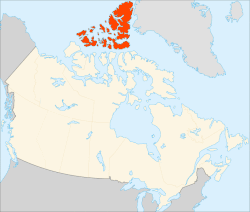Arctic wolf
| Arctic Wolf | |
|---|---|

| |
| Scientific classification | |
| Kingdom: | |
| Phylum: | |
| Class: | |
| Order: | |
| Family: | |
| Genus: | |
| Species: | |
| Subspecies: | C. l. arctos
|
| Trinomial name | |
| Canis lupus arctos Pocock, 1935
| |

| |
| Arctic Wolf range | |
The Arctic Wolf (Canis lupus arctos), also called Polar Wolf or White Wolf, is a mammal of the Canidae family, and a subspecies of the Gray Wolf. It is often confused with the Tundra Wolf (Canis lupus albus), which can be found throughout northern Europe and Asia. Arctic Wolves inhabit the Canadian Arctic and the northern parts of Greenland.
Anatomy
- See also: Gray Wolf Features and Adaptations
Arctic Wolves generally are smaller than Gray Wolves, being about 90 to 150 cm (3 to 5 feet) long including the tail; males are larger than females. Their shoulder heights vary from 65 to 80 cm (25 to 31 inches); Arctic Wolves are bulkier than Gray Wolves, often weighing over 45 kg (100 pounds). Weights of up to 80 kg (175 pounds) have been observed in full-grown males.
Arctic Wolves have achieved lifespans of over 17 years in captivity; however, in the wild, the average lifespan is only 7 years.
Hunting
Arctic Wolves, like all wolves, hunt in packs; they mostly prey on Caribou and musk oxen, but will also kill Arctic Hares, and lemmings, as well as other smaller animals. Due to the scarcity of grazing plants, they roam large areas to find prey up to and beyond 2600 km2 (1000 square miles), and they will follow migrating Caribou south during the winter.
Their colors can vary from red, gray, white and black.

Reproduction ==
- See also: Gray Wolf Courtship and Mating
Normally, only the alpha male and female breed, but in large packs others may mate as well. Due to the Arctic's permafrost soil and the difficulty it poses for digging dens, Arctic Wolves often use rock outcroppings, caves or even shallow depressions as dens instead; the mother gives birth to two to three pups in late May to early June, about a month later than Gray Wolves. It is generally thought that the lower number of pups compared to the average of 5 to 6 among Gray Wolves is due to the scarcity of prey in the Arctic. They give birth in about 63 days.
Distribution
The Arctic Wolf is the only subspecies of the Gray Wolf that still can be found over the whole of its original range; largely because in their natural habitat they rarely encounter humans.
References
- L. David Mech (text), Jim Brandenburg (photos), At home with the arctic wolf, National Geographic Vol. 171 No. 5 (May 1987), pp. 562-593
- L. David Mech, The arctic wolf: 10 years with the pack, Voyageur Press 1997, ISBN 0896583538
